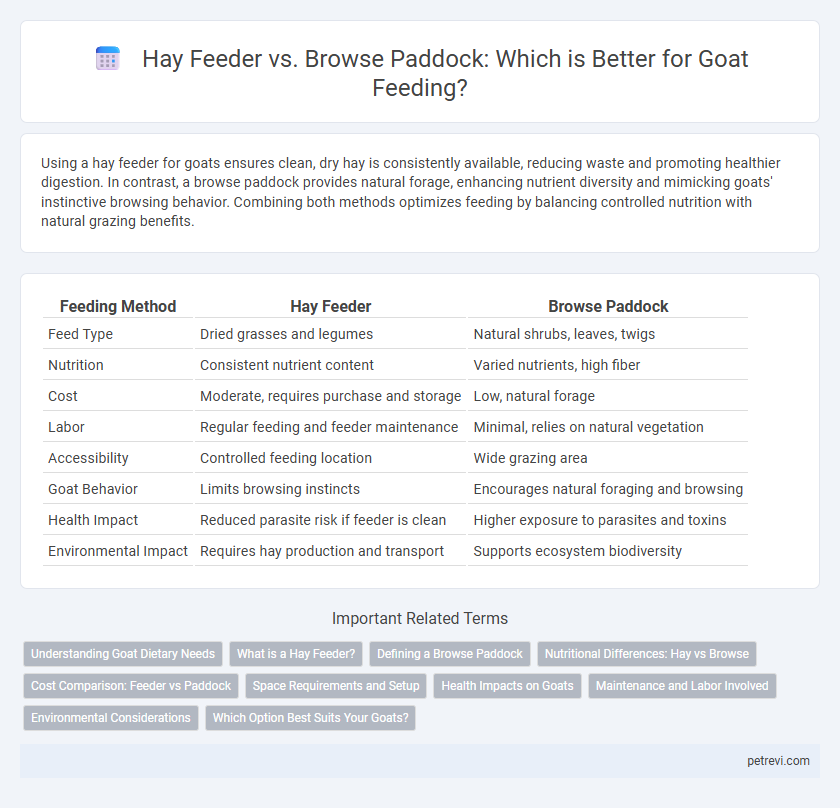Using a hay feeder for goats ensures clean, dry hay is consistently available, reducing waste and promoting healthier digestion. In contrast, a browse paddock provides natural forage, enhancing nutrient diversity and mimicking goats' instinctive browsing behavior. Combining both methods optimizes feeding by balancing controlled nutrition with natural grazing benefits.
Table of Comparison
| Feeding Method | Hay Feeder | Browse Paddock |
|---|---|---|
| Feed Type | Dried grasses and legumes | Natural shrubs, leaves, twigs |
| Nutrition | Consistent nutrient content | Varied nutrients, high fiber |
| Cost | Moderate, requires purchase and storage | Low, natural forage |
| Labor | Regular feeding and feeder maintenance | Minimal, relies on natural vegetation |
| Accessibility | Controlled feeding location | Wide grazing area |
| Goat Behavior | Limits browsing instincts | Encourages natural foraging and browsing |
| Health Impact | Reduced parasite risk if feeder is clean | Higher exposure to parasites and toxins |
| Environmental Impact | Requires hay production and transport | Supports ecosystem biodiversity |
Understanding Goat Dietary Needs
Goats require a diverse diet rich in fiber, nutrients, and minerals to maintain optimal health, making both hay feeders and browse paddocks essential components of their feeding regimen. Hay feeders provide controlled access to dry forage, ensuring consistent fiber intake to support rumen function, while browse paddocks offer natural vegetation like shrubs and leaves that fulfill goats' instinctual browsing behavior and supply vital micronutrients. Balancing hay feeding with access to browse paddocks aligns closely with goats' natural dietary needs, promoting better digestion, immunity, and overall productivity.
What is a Hay Feeder?
A hay feeder is a specialized structure designed to hold and dispense hay, minimizing waste while providing goats with easy access to their primary forage. Typically constructed from metal or wood, hay feeders help maintain the nutritional quality of hay by keeping it off the ground and protected from moisture. This feeding method contrasts with browse paddocks, where goats forage on shrubs and trees, offering a natural diet that complements the controlled environment of hay feeders.
Defining a Browse Paddock
A browse paddock for goats is a designated grazing area rich in shrubs, trees, and woody plants, providing natural forage that mimics their instinctual browsing behavior. Unlike hay feeders that supply dried grasses and legumes, browse paddocks offer diverse nutrients and fiber through live plant material, supporting digestive health and natural feeding habits. Properly managed browse paddocks can improve goat nutrition, promote selective feeding, and reduce feed costs by utilizing available vegetation efficiently.
Nutritional Differences: Hay vs Browse
Hay feeders provide goats with dried grasses and legumes, offering a consistent source of fiber and energy, but often lack the diverse micronutrients found in fresh browse. Browse paddocks supply goats with leaves, twigs, and shrubs rich in vitamins, minerals, and secondary plant compounds that enhance digestion and immune function. Nutritionally, browse can improve health and productivity by contributing antioxidants and varied nutrients absent in most hay diets.
Cost Comparison: Feeder vs Paddock
Hay feeders require an initial investment for materials and installation, but minimize feed wastage and reduce ongoing feeding costs by preserving hay quality. Browse paddocks have lower upfront expenses as they use natural vegetation, yet demand land management and may lead to inconsistent nutrient supply, potentially increasing supplemental feed costs. Over time, hay feeders offer predictable budget control, whereas browse paddocks fluctuate in cost depending on forage availability and maintenance.
Space Requirements and Setup
Hay feeders for goats typically require less space compared to browse paddocks, making them ideal for smaller or confined areas. Setup of hay feeders is straightforward, involving minimal infrastructure such as a rack or trough, while browse paddocks demand larger land areas and fencing to allow goats to graze on shrubs and bushes. Efficient space management in hay feeders reduces feed waste, whereas browse paddocks provide natural foraging but require more extensive planning and maintenance.
Health Impacts on Goats
Hay feeders provide goats with controlled access to dry forage, reducing mold exposure and minimizing the risk of respiratory issues, which supports overall digestive health. Browse paddocks offer diverse plant species that promote natural foraging behavior and improve nutrient intake, enhancing immune function and reducing parasitic infestations. Selecting the appropriate feeding method depends on balancing dietary variety and hygiene to optimize goat health outcomes.
Maintenance and Labor Involved
Hay feeders require regular cleaning to prevent mold and waste buildup, demanding daily labor input to maintain hygiene and feed quality. Browse paddocks involve natural forage with less daily maintenance but require periodic management like pruning and reseeding to sustain plant health. Labor for browse paddocks is typically seasonal and less intensive compared to the continuous upkeep needed for hay feeders.
Environmental Considerations
Hay feeders minimize feed wastage and reduce soil compaction, preserving pasture health and preventing erosion in goat grazing areas. Browse paddocks encourage natural foraging behavior, promote vegetation diversity, and support sustainable land use by maintaining the ecological balance. Selecting a feeding method based on land condition and local flora helps optimize environmental benefits while ensuring goat nutrition.
Which Option Best Suits Your Goats?
Hay feeders provide controlled, clean, and consistent access to dry forage, reducing waste and preventing contamination for goats, making them ideal in confined or dry environments. Browse paddocks offer natural vegetation variety, supporting goats' browsing behavior and improving nutrition through diverse plant species, especially in extensive or pasture-based systems. Selecting between hay feeders and browse paddocks depends on your goats' grazing habits, the available land, and environmental conditions to optimize health and performance.
Hay feeder vs Browse paddock for Goat feeding Infographic

 petrevi.com
petrevi.com